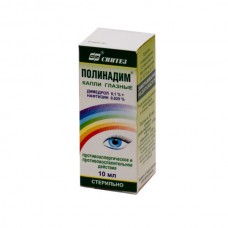Expiration date: 10/2025
Release form and composition:
Eye drops in the form of a clear, slightly colored liquids.
1 ml contains:
diphenhydramine 1 mg
naphazoline 250 mcg
Excipients: boric acid (15 mg/ml), methylcellulose water-soluble (1.5 mg/ml), sodium tetraborate decahydrate (500 µg/ml), disodium edetate (600 µg/ml), water d/and (up to 1 ml).
10ml dropper bottle plastic (1) - packs of cardboard.
Pharmacological action:
Combined product for local use in ophthalmology.
Diphenhydramine - blocker of histamine H1-receptors, has anti-allergic effect. Reduces swelling, itching, watery eyes.
Naphazoline - alpha agonists, causes prolonged peripheral vasoconstriction. Thanks to the vasoconstrictor action of the local application has anti-edema effect.
Pharmacokinetics:
Data on the pharmacokinetics of the drug Polindes® is not available.
Indications:
acute allergic conjunctivitis (including conjunctivitis pollinozy)
— conjunctivitis with drug Allergy
— infectious eye disease with acute allergic component (as additional funds).
Dosing regimen:
Adults for acute symptoms the drug is prescribed 1 drop in the conjunctival SAC every 3 h to reduce swelling and irritation of the eyes, then 1 drop 2-3 times/day until the disappearance of clinical symptoms.
Children over 2 years appoint 1-2 drops/day.
Duration of treatment - no more than 5 days. The need for a more prolonged use of the drug the doctor decides individually.
If symptoms of irritation of the conjunctiva for more than 72 hours, discontinue use of the drug.
Side effects:
Local reactions: symptoms of irritation of the conjunctiva (burning sensation in eye, conjunctival hyperemia, itching), and also blurred vision, increased intraocular pressure, mydriasis, eye pain, dryness of the nasal mucosa. These reactions disappear after discontinuation of the drug. Described a single case of corneal opacities (when applied for 7 days at least 10 times/day), which disappeared after cessation of drug treatment.
Systemic reaction: rare (especially in children and elderly patients) - pallor, tachycardia, pain in heart, increased blood pressure, increased sweating, tremor, headache, agitation, nausea, drowsiness, dizziness.
Contraindications:
— conjunctival xerosis (dry keratoconjunctivitis, Sjogren's syndrome)
— simultaneous application with MAO inhibitors and the period during 10 days after their cancellation
— angle-closure glaucoma
— pregnancy
— lactation
— children up to age 2 years
— hypersensitivity to the drug.
With caution the drug should be used in thyrotoxicosis, hypertension, atherosclerosis, arrhythmia, chronic rhinitis, bronchial asthma, adrenal adenoma, elderly patients, in benign prostatic hyperplasia with residual urine.
Pregnancy and lactation:
The use of the drug during pregnancy and lactation (breastfeeding) is possible only in the case when expected benefit for mother exceeds potential risk for fetus or child.
Special instructions:
You should not use the drug more often than every 3 hours (within 5 days).
The drug is not intended for ingestion or administration by injection.
In the case of the onset of symptoms, evidence of systemic absorption, it is necessary to discontinue the drug.
When Allergy symptoms and during treatment it is not recommended to use soft contact lenses. If their use is necessary, the lenses should be removed before instillation and set it back, not earlier than 15 min.
Effects on ability to drive vehicles and management mechanisms
Because after instillation temporarily disturbed the clarity of view, immediately after treatment, patients should refrain from driving vehicles and activities that require visual acuity.
Overdose:
The local application of the drug overdose unlikely.
Symptoms: in children under 6 years of age with prolonged and frequent use may CNS depression, hypothermia, prolonged mydriasis, increased blood pressure, tachycardia.
Treatment: symptomatic therapy.
Drug interactions:
While the use of tricyclic antidepressants may increase the vasoconstrictor action of naphazoline.
The use of MAO inhibitors concurrently with naphazoline or within 10 days after their withdrawal can lead to hypertensive crisis.
Terms and conditions of storage:
The drug should be stored out of the reach of children, protected from light place at a temperature of from 15° to 25°C do not freeze. Shelf life - 2 years.
After opening the bottle shelf life of the drug to 1 month.
Polynadim
(Diphenhydramine
+
Naphazoline)
10ml
eye
drops
- Brand: Sintez

- Availability:
in stock
Categories:
-
$4.00

